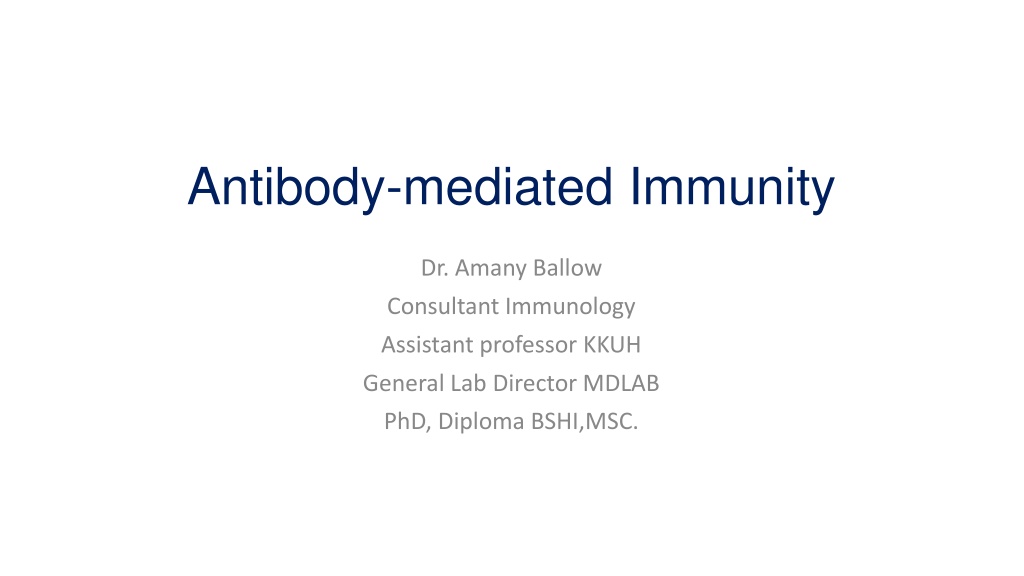Understanding Antibody-Mediated Immunity in Humoral Immunity
This content delves into the mechanisms of antibody-mediated immunity, focusing on B-cells as key players in humoral immunity. It covers topics such as activation of B-cells, clonal selection, generation of plasma and memory cells, primary and secondary immune responses, and the structure and function of immunoglobulins. The role of antigens, T-dependent and T-independent responses, and the distinction between self and non-self antigens are thoroughly explored.
Download Presentation

Please find below an Image/Link to download the presentation.
The content on the website is provided AS IS for your information and personal use only. It may not be sold, licensed, or shared on other websites without obtaining consent from the author. Download presentation by click this link. If you encounter any issues during the download, it is possible that the publisher has removed the file from their server.
E N D
Presentation Transcript
Antibody-mediated Immunity Dr. Amany Ballow Consultant Immunology Assistant professor KKUH General Lab Director MDLAB PhD, Diploma BSHI,MSC.
Objectives Objectives To describe B-cells as the mediators of humoral immunity, (antibody- mediated immunity) 2. To describe activation of B-cells which involve: -Antigen recognition -T-dependent & T-independent antigens - Requirement for T-helper cells 3. To explain clonal selection, clonal expansion & generation of plasma cells & memory cells 4. To describe primary & secondary immune responses 5. To describe the structure & function of Immunoglobulins
Humoral Immunity Humoral Immunity Humoral immunity is so named because it involves substances found in the humours or body fluids The Humoral Immune Response is the aspect of immunity that is mediated by secreted antibodies
Activation of B cells by antigens 1-T-dependent - Antibody production by B-cells require T-helper cells - Macrophages recognize antigen & present it to T-helper cells - T-helper cells stimulate B-cells specific for that antigen to become plasma cells - T-dependent antigens are mainly proteins on viruses, bacteria & other foreign materials.
Activation of B Activation of B- -cells by antigens cells by antigens 2-T-independent antigens 1. 2. B-cells do not require T-helper cells to produce antibody. Antigens are mainly polysaccharides or lipo-polysaccrides with repeating subunits example :bacterial capsule. 3. Immune responses are weak compared to T-dependent responses.
Antigens Antigens Self versus non-self T cells and B cells removed if they recognize self proteins Antigens are mostly proteins or polysaccharides Antigenic determinants (epitopes) Each bacterial cell has many different epitopes
Antibodies Antibodies Antibodies are immunoglobulins (Ig) with specific functions. Antibodies are found in extracellular fluids (blood plasma, lymph, mucus, etc.) and the surface of B cells. Antibodies bind to specific sites on antigen surfaces and perform protective functions by different mechanisms. There is a specific antibody for each antigen stimulate the immune response.
Antibody function Antibody function
Antibody structure and function 1. Made up of four polypeptides (amino acid chains). 2. Two longer and larger (heavy chains ) and the other two shorter and smaller (light chains) 3. Have the shape of a letter Y
Variable region has the potential to bind with particular classes of antigens. Once a raw antibody is stimulated to fit to a specific antigen, it can then react with ONLY that antigen .This is known as SINGLE SPECIFICITY Can fit as precisely as a lock-and-key to an antigen. Constant regions. Fc region (stem) - can bind complement
Antibody dependent cell Antibody dependent cell- -mediated cytotoxicity mediated cytotoxicity Antibodies coat infecting cell (large parasite usually) - FC facing outwards NK (lysing ability), Macrophage, neutrophils, and eosinophils have receptors for FC region of antibody Secretion of lytic enzymes to destroy parasite
Concentration & type of antibody in primary & Concentration & type of antibody in primary & secondary immune responses secondary immune responses
Comparison between primary & secondary Comparison between primary & secondary responses responses
Summary Summary B cells can be activated by antigen to produce antibodies either with the assistance of helper T cells or directly by the antigen itself Antibodies are made up of two heavy and two light amino acid chains and have a shape of letter Y Different types of antibodies are located at various sites to provide protection by agglutination, precipitation, complement fixation etc. Secondary humoral immune response is swift and a stronger immune response mediated by IgG class of antibodies because of the memory cells.

























